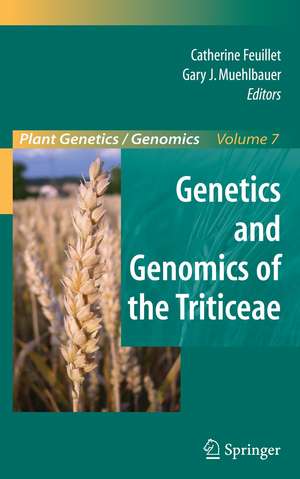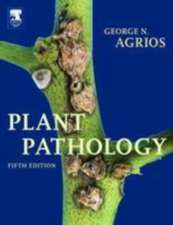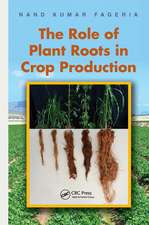Genetics and Genomics of the Triticeae: Plant Genetics and Genomics: Crops and Models, cartea 7
Editat de Catherine Feuillet, Gary J. Muehlbaueren Limba Engleză Paperback – 2 dec 2011
Cereals constitute over 50% of total crop production worldwide (http://www.fao.org/) and cereal seeds are one of the most important renewable resources for food, feed, and industrial raw materials. Crop species of the Triticeae tribe that comprise wheat, barley, and rye are essential components of human and domestic animal nutrition. With 17% of all crop area, wheat is the staple food for 40% of the world’s population, while barley ranks fifth in the world production. Their domestication in the Fertile Crescent 10,000 years ago ushered in the beginning of agriculture and signified an important breakthrough in the advancement of civilization. Rye is second after wheat among grains most commonly used in the production of bread and is also very important for mixed animal feeds. It can be cultivated in poor soils and climates that are generally not suitable for other cereals.
Extensive genetics and cytogenetics studies performed in the Triticeae species over the last 50 years have led to the characterization of their chromosomal composition and origins and have supported intensive work to create new genetic resources. Cytogenetic studies in wheat have allowed the identification and characterization of the different homoeologous genomes and have demonstrated the utility of studying wheatgenome evolution as a model for the analysis of polyploidization, a major force in the evolution of the eukaryotic genomes. Barley with its diploid genome shows high collinearity with the other Triticeae genomes and therefore serves as a good template for supporting genomic analyses in the wheat and rye genomes. The knowledge gained from genetic studies in the Triticeae has also been used to produce Triticale, the first human made hybrid crop that results from a cross between wheat and rye and combines the nutrition quality and productivity of wheat with the ruggedness of rye.
Despite the economic importance of the Triticeae species and the need for accelerated crop improvement based on genomics studies, the size (1.7 Gb for the bread wheat genome, i.e., 5x the human genome and 40 times the rice genome), high repeat content (>80%), and complexity (polyploidy in wheat) of their genomes often have been considered too challenging for efficient molecular analysis and genetic improvement in these species. Consequently, Triticeae genomics has lagged behind the genomic advances of other cereal crops for many years.
Recently, however, the situation has changed dramatically and robust genomic programs can be established in the Triticeae as a result of the convergence of several technology developments that have led to new, more efficient scientific capabilities and resources such as whole-genome and chromosome-specific BAC libraries, extensive EST collections, transformation systems, wild germplasm and mutant collections, as well as DNA chips.
Currently, the Triticeae genomics "toolbox" is comprised of:
- 9 publicly available BAC libraries from diploid (5), tetraploid (1) and hexaploid (3) wheat; 3 publicly available BAC libraries from barley and one BAC library from rye;
- 3 wheat chromosome specific BAC libraries;
- DNA chips including commercially available first generation chips from AFFYMETRIX containing 55’000 wheat and22,000 barley genes;
- A large number of wheat and barley genetic maps that are saturated by a significant number of markers;
- The largest plant EST collection with 870’000 wheat ESTs, 440’000 barley ESTs and about 10’000 rye ESTs;
- Established protocols for stable transformation by biolistic and agrobacterium as well as a transient expression system using VIGS in wheat and barley; and
- Large collections of well characterized cultivated and wild genetic resources.
International consortia, such as the International Triticeae Mapping Initiative (ITMI), have advanced synergies in the Triticeae genetics community in the development of additional mapping populations and markers that have led to a dramatic improvement in the resolution of the genetic maps and the amount of molecular markers in the three species resulting in the accelerated utilization of molecular markers in selection programs. Together, with the development of the genomic resources, the isolation of the first genes of agronomic interest by map-based cloning has been enabled and has proven the feasibility of forging the link between genotype and phenotype in the Triticeae species. Moreover, the first analyses of BAC sequences from wheat and barley have allowed preliminary characterizations of their genome organization and composition as well as the first inter- and intra-specific comparative genomic studies. These later have revealed important evolutionary mechanisms (e.g. unequal crossing over, illegitimate recombination) that have shaped the wheat and barley genomes during their evolution. These breakthroughs have demonstrated the feasibility of developing efficient genomic studies in the Triticeae and have led to the recent establishment of the International Wheat Genome Sequencing Consortium (IWGSC) (http//:www.wheatgenome.org) and the International Barley Sequencing Consortium (www.isbc.org) that aim to sequence, respectively, the hexaploid wheat and barleygenomes to accelerate gene discovery and crop improvement in the next decade. Large projects aiming at the establishment of the physical maps as well as a better characterization of their composition and organization through large scale random sequencing projects have been initiated already. Concurrently, a number of projects have been launched to develop high throughput functional genomics in wheat and barley. Transcriptomics, proteomics, and metabolomics analyses of traits of agronomic importance, such as quality, disease resistance, drought, and salt tolerance, are underway in both species. Combined with the development of physical maps, efficient gene isolation will be enabled and improved sequencing technologies and reduced sequencing costs will permit ultimately genome sequencing and access to the entire wheat and barley gene regulatory elements repertoire. Because rye is closely related to wheat and barley in Triticeae evolution, the latest developments in wheat and barley genomics will be of great use for developing rye genomics and for providing tools for rye improvement. Finally, a new model for temperate grasses has emerged in the past year with the development of the genetics and genomics (including a 8x whole genome shotgun sequencing project) of Brachypodium, a member of the Poeae family that is more closely related to the Triticeae than rice and can provide valuable information for supporting Triticeae genomics in the near future.
These recent breakthroughs have yet to be reviewed in a single source of literature and current handbooks on wheat, barley, or rye are dedicated mainly to progress in genetics. In "Genetics and Genomics of the Triticeae", we will aim to comprehensively review the recent progress in the development of structural and functional genomics tools in the Triticeae species and review the understanding of wheat, barley, and rye biology that has resulted from these new resources as well as to illuminate how this new found knowledge can be applied for the improvement of these essential species. The book will be the seventh volume in the ambitious series of books, Plant Genetics and Genomics (Richard A. Jorgensen, series editor) that will attempt to bring the field up-to-date on the genetics and genomics of important crop plants and genetic models. It is our hope that the publication will be a useful and timely tool for researchers and students alike working with the Triticeae.
| Toate formatele și edițiile | Preț | Express |
|---|---|---|
| Paperback (1) | 1240.47 lei 6-8 săpt. | |
| Springer – 2 dec 2011 | 1240.47 lei 6-8 săpt. | |
| Hardback (1) | 1246.47 lei 3-5 săpt. | |
| Springer – 20 iul 2009 | 1246.47 lei 3-5 săpt. |
Din seria Plant Genetics and Genomics: Crops and Models
- 18%
 Preț: 967.40 lei
Preț: 967.40 lei - 18%
 Preț: 1235.88 lei
Preț: 1235.88 lei - 18%
 Preț: 956.33 lei
Preț: 956.33 lei - 18%
 Preț: 1233.06 lei
Preț: 1233.06 lei - 18%
 Preț: 955.08 lei
Preț: 955.08 lei - 18%
 Preț: 1228.29 lei
Preț: 1228.29 lei - 18%
 Preț: 1121.13 lei
Preț: 1121.13 lei - 18%
 Preț: 1009.54 lei
Preț: 1009.54 lei - 20%
 Preț: 574.08 lei
Preț: 574.08 lei - 18%
 Preț: 943.73 lei
Preț: 943.73 lei - 18%
 Preț: 948.92 lei
Preț: 948.92 lei - 18%
 Preț: 1234.14 lei
Preț: 1234.14 lei - 18%
 Preț: 2116.19 lei
Preț: 2116.19 lei - 18%
 Preț: 1221.69 lei
Preț: 1221.69 lei - 18%
 Preț: 1235.43 lei
Preț: 1235.43 lei - 9%
 Preț: 1007.66 lei
Preț: 1007.66 lei
Preț: 1240.47 lei
Preț vechi: 1512.77 lei
-18% Nou
Puncte Express: 1861
Preț estimativ în valută:
237.39€ • 247.53$ • 197.29£
237.39€ • 247.53$ • 197.29£
Carte tipărită la comandă
Livrare economică 21 martie-04 aprilie
Preluare comenzi: 021 569.72.76
Specificații
ISBN-13: 9781461417064
ISBN-10: 1461417066
Pagini: 700
Ilustrații: 700 p. 74 illus., 22 illus. in color.
Dimensiuni: 155 x 235 x 40 mm
Greutate: 1.1 kg
Ediția:2009
Editura: Springer
Colecția Springer
Seria Plant Genetics and Genomics: Crops and Models
Locul publicării:New York, NY, United States
ISBN-10: 1461417066
Pagini: 700
Ilustrații: 700 p. 74 illus., 22 illus. in color.
Dimensiuni: 155 x 235 x 40 mm
Greutate: 1.1 kg
Ediția:2009
Editura: Springer
Colecția Springer
Seria Plant Genetics and Genomics: Crops and Models
Locul publicării:New York, NY, United States
Public țintă
ResearchCuprins
Genetics of the Triticeae.- Scientific Names in the Triticeae.- Triticeae Genetic Resources in ex situ Genebank Collections.- Domestication of the Triticeae in the Fertile Crescent.- Cytogenetic Analysis of Wheat and Rye Genomes.- Applying Cytogenetics and Genomics to Wide Hybridisations in the Genus Hordeum.- Methods for Genetic Analysis in the Triticeae.- Genetic Mapping in the Triticeae.- Early Stages of Meiosis in Wheat- and the Role of Ph1.- Tools, Resources and Approaches.- A Toolbox for Triticeae Genomics.- Chromosome Genomics in the Triticeae.- Physical Mapping in the Triticeae.- Map-Based Cloning of Genes in Triticeae (Wheat and Barley).- Functional Validation in the Triticeae.- Genomics of Transposable Elements in the Triticeae.- Gene and Repetitive Sequence Annotation in the Triticeae.- Brachypodium distachyon, a New Model for the Triticeae.- Comparative Genomics in the Triticeae.- Genetics and Genomics of Triticeae Biology.- Genomics of Tolerance to Abiotic Stress in the Triticeae.- Genomics of Biotic Interactions in the Triticeae.- Developmental and Reproductive Traits in the Triticeae.- Genomics of Quality Traits.- Early messages.- Linkage Disequilibrium and Association Mapping in the Triticeae.- Triticeae Genome Structure and Evolution.- Wheat and Barley Genome Sequencing.
Recenzii
From the reviews:
“Describe the latest advances in genetics and genomics of the economically important Triticeae tribe … . This is a very timely text that will be of great interest and value to both graduate students and postgraduates … . I would also strongly recommend this text to researchers entering the field attracted by the new opportunities that are emerging in these important species. I believe this book will serve as a go-to reference for the coming years to those working on Triticeae genetics and genomics.” (Cristobal Uauy, Annals of Botany, Vol. 108 (5), October, 2011)
“Describe the latest advances in genetics and genomics of the economically important Triticeae tribe … . This is a very timely text that will be of great interest and value to both graduate students and postgraduates … . I would also strongly recommend this text to researchers entering the field attracted by the new opportunities that are emerging in these important species. I believe this book will serve as a go-to reference for the coming years to those working on Triticeae genetics and genomics.” (Cristobal Uauy, Annals of Botany, Vol. 108 (5), October, 2011)
Notă biografică
Catherine Feuillet is research director and leader of the group "Structure, function and evolution of the wheat genomes" at the INRA, Clermont-Ferrand (France). She was educated as a geneticist and molecular biologist and worked for 10 years in Switzerland on the genomics of disease resistance in wheat and barley before moving to France. She is one of the co-chairs of the International Wheat Genome Sequencing Consortium (IWGSC), the International Triticeae Mapping Initiative (ITMI), and the European Triticeae Genomics Initiative (ETGI).
Gary J. Muehlbauer is an Associate Professor and Endowed Chair in Molecular Genetics of Crop Improvement in the Department of Agronomy and Plant Genetics at the University of Minnesota. He studied maize genetics during his Ph.D. at the University of Minnesota and his postdoctoral work at the University of California at Berkeley. He has been on the faculty at the University of Minnesota for eleven years working on barley and wheat genomics. He is the vice chair of the International Barley Sequencing Consortium.
Gary J. Muehlbauer is an Associate Professor and Endowed Chair in Molecular Genetics of Crop Improvement in the Department of Agronomy and Plant Genetics at the University of Minnesota. He studied maize genetics during his Ph.D. at the University of Minnesota and his postdoctoral work at the University of California at Berkeley. He has been on the faculty at the University of Minnesota for eleven years working on barley and wheat genomics. He is the vice chair of the International Barley Sequencing Consortium.
Textul de pe ultima copertă
Genetics and Genomics of Triticeae
Edited by Catherine Feuillet and Gary Muehlbauer
Domestication of cereals in the Fertile Crescent 10,000 years ago ushered in the beginning of agriculture, and signified a remarkable breakthrough in the advancement of civilization. Today, the crops of the Triticeae tribe, wheat, barley, and rye, constitute over 50% of total crop production worldwide (http://www.fao.org/) and cereal seeds are one of the most important renewable resources for food, feed, and industrial raw materials. The economic importance of the Triticeae has triggered intense cytogenetic and genetic studies over the past few decades, and has resulted in a breadth of information and tools for developing wheat, barley, and rye varieties. Hampered by the size and complexity of their genomes, however, research regarding the genomics of the Triticeae has lagged behind. But, the recent convergence of several technology developments has enabled dramatic breakthroughs in genomic research and led to the development of a robust "Genomic toolbox." These new capabilities permit a better understanding of the biology of the Triticeae plants and support the improvement of agronomically important traits in these essential species.
Comprised of the work of internationally recognized experts, Genetics and Genomics of Triticeae provides an in depth summary of the advances of the past decades, synthesizes the current state of knowledge of the structure, function, and evolution of the Triticeae genomes, and describes progress in the application of this knowledge to the improvement of wheat, barley, and rye. This book explores both the fundamentals of genetic and genomic research of the Triticeae and the applications of state of the art technology that have led to improvements in agronomically important traits such as biotic and abiotic stress resistance, plant development, and quality. Genetics and Genomics of Triticeae opens perspectives into the deployment of new genetic approaches to identify traits and create a better understanding of the organization of the Triticeae genome, and the ongoing development of new sequencing technologies that will support future genome sequencing of these essential crops.
Catherine Feuillet is research director and leader of the group "Structure, function and evolution of the wheat genomes" at the INRA, Clermont-Ferrand (France). She was educated as a geneticist and molecular biologist and worked for 10 years in Switzerland on the genomics of disease resistance in wheat and barley before moving to France. She is one of the co-chairs of the International Wheat Genome Sequencing Consortium (IWGSC), the International Triticeae Mapping Initiative (ITMI), and the European Triticeae Genomics Initiative (ETGI).
Gary J. Muehlbauer is an Associate Professor and Endowed Chair in Molecular Genetics of Crop Improvement in the Department of Agronomy and Plant Genetics at the University of Minnesota. He studied maize genetics during his Ph.D. at the University of Minnesota and his postdoctoral work at the University of California at Berkeley. He has been on the faculty at the University of Minnesota for eleven years working on barley and wheat genomics. He is the vice chair of the International Barley Sequencing Consortium.
Edited by Catherine Feuillet and Gary Muehlbauer
Domestication of cereals in the Fertile Crescent 10,000 years ago ushered in the beginning of agriculture, and signified a remarkable breakthrough in the advancement of civilization. Today, the crops of the Triticeae tribe, wheat, barley, and rye, constitute over 50% of total crop production worldwide (http://www.fao.org/) and cereal seeds are one of the most important renewable resources for food, feed, and industrial raw materials. The economic importance of the Triticeae has triggered intense cytogenetic and genetic studies over the past few decades, and has resulted in a breadth of information and tools for developing wheat, barley, and rye varieties. Hampered by the size and complexity of their genomes, however, research regarding the genomics of the Triticeae has lagged behind. But, the recent convergence of several technology developments has enabled dramatic breakthroughs in genomic research and led to the development of a robust "Genomic toolbox." These new capabilities permit a better understanding of the biology of the Triticeae plants and support the improvement of agronomically important traits in these essential species.
Comprised of the work of internationally recognized experts, Genetics and Genomics of Triticeae provides an in depth summary of the advances of the past decades, synthesizes the current state of knowledge of the structure, function, and evolution of the Triticeae genomes, and describes progress in the application of this knowledge to the improvement of wheat, barley, and rye. This book explores both the fundamentals of genetic and genomic research of the Triticeae and the applications of state of the art technology that have led to improvements in agronomically important traits such as biotic and abiotic stress resistance, plant development, and quality. Genetics and Genomics of Triticeae opens perspectives into the deployment of new genetic approaches to identify traits and create a better understanding of the organization of the Triticeae genome, and the ongoing development of new sequencing technologies that will support future genome sequencing of these essential crops.
Catherine Feuillet is research director and leader of the group "Structure, function and evolution of the wheat genomes" at the INRA, Clermont-Ferrand (France). She was educated as a geneticist and molecular biologist and worked for 10 years in Switzerland on the genomics of disease resistance in wheat and barley before moving to France. She is one of the co-chairs of the International Wheat Genome Sequencing Consortium (IWGSC), the International Triticeae Mapping Initiative (ITMI), and the European Triticeae Genomics Initiative (ETGI).
Gary J. Muehlbauer is an Associate Professor and Endowed Chair in Molecular Genetics of Crop Improvement in the Department of Agronomy and Plant Genetics at the University of Minnesota. He studied maize genetics during his Ph.D. at the University of Minnesota and his postdoctoral work at the University of California at Berkeley. He has been on the faculty at the University of Minnesota for eleven years working on barley and wheat genomics. He is the vice chair of the International Barley Sequencing Consortium.
Caracteristici
A modern and comprehensive volume on the status and future of triticeae







